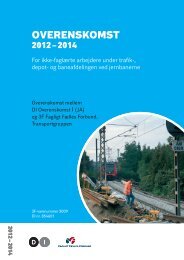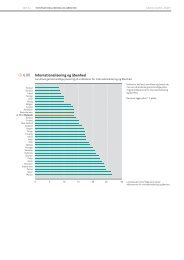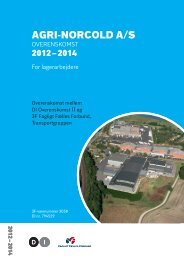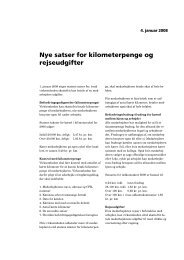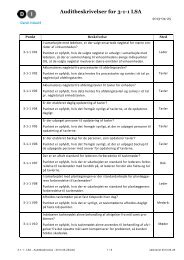Hydrogen and its competitors, 2004
Hydrogen and its competitors, 2004
Hydrogen and its competitors, 2004
You also want an ePaper? Increase the reach of your titles
YUMPU automatically turns print PDFs into web optimized ePapers that Google loves.
Risø Energy Report 3<strong>Hydrogen</strong> <strong>and</strong> the environment 616.1Temperature change (K)0,0-0,5-1,0Our estimateTromp et alassumption0-5-10-15-20O 2 depletion (%)Figure 32: Relative temperature changes in the lower stratosphere at74°N (solid line) <strong>and</strong> the resulting maximum ozone depletion in thenorthern polar vortex (dashed line) as a function of increased atmospherichydrogen concentrations relative to the today's actual hydrogenconcentration of about 0.5 ppmv. The cause of the temperature changeis the stratospheric water vapour resulting from the oxidation of hydrogen.The graph is taken from Tromp et al. [15], with additions.-1,5123 4 5H 2 Increase (fold)6-257OH concentration has probably remained stable in about10% over this time.Significant future changes in either NO x or carbonmonoxide emissions could have a much larger effect onOH levels. Such changes could happen in a hydrogeneconomy, but equally they could happen in a world offossil fuels as a result of tightening emission controls.More research is clearly needed to produce reliable estimatesbased on probable emission scenarios.2. Changes in atmospheric water vapourThe oxidation of hydrogen produces water vapour,which could have different consequences depending onwhere in the atmosphere it is released. One recent articlesuggests that increasing atmospheric hydrogen concentrationsby a factor of four would increase the amount ofwater vapour in the stratosphere by up to 30% [15].According to these researchers, this could decrease thelower stratospheric temperature at the polar vortex byabout 0.2°C, which in turn could trigger additional polarozone losses of up to 8% (polar ozone depletion is verysensitive to small temperature changes [17]). Anothermodel, however, showed a much weaker effect on stratospherictemperatures <strong>and</strong> ozone loss [16].As discussed above, hydrogen levels are more likely toincrease by 20% than by 400% in the coming decades.Even when we use the more pessimistic model [15], theconsequences for stratospheric temperatures <strong>and</strong> ozoneconcentrations therefore are expected to be negligible(Figure 32).Increased water vapour concentrations in the uppertroposphere can be expected if air traffic increases asprojected, especially if aircrafts begin to use hydrogen asfuel. At these altitudes, increased water vapour maycause cirrus clouds to form. This would increase ordecrease heat radiation, depending on the height <strong>and</strong>thickness of the cloud, <strong>and</strong> might lead to either coolingor warming of the atmosphere.It is difficult to establish reliable estimates of the potentialwater vapour release from aircrafts, <strong>and</strong> even harderto model the effects of extra water vapour on this highlysensitiveregion of the atmosphere. Emissions dependstrongly on engine design, <strong>and</strong> the effects will be verydifferent depending on the altitude, air temperature,exhaust temperature <strong>and</strong> background humidity.If hydrogen combustion engines were used widely inaircrafts, another source of concern could be emissions ofNO x . Even under present-day conditions, NO x emissionsare believed to significantly perturb the amount of ozonein the upper troposphere [6]. These processes in theupper troposphere <strong>and</strong> lower stratosphere region are stillthe subject of much research, <strong>and</strong> more measurements<strong>and</strong> better models are needed to assess them reliably.3. Soil uptakeThe uptake of atmospheric hydrogen by soil microorganismsor organic remnants is associated with largeuncertainties. Studies using isotopically-labelled hydrogensuggest that soil uptake provides about 75% of thetotal hydrogen sink, but there is a large margin of error.Little is known about the detailed processes by whichhydrogen is absorbed in the soil.At the moment there is no sign that the process ofhydrogen uptake in the soil is becoming saturated.Increased fossil fuel combustion has presumablyincreased atmospheric hydrogen concentrations significantlyin the last century, but there has been nodetectable increase since 1990. If hydrogen uptake in thesoil were becoming saturated, we would expect theconcentration of hydrogen in the atmosphere to haveincreased, even if hydroxyl radical concentration wereincreasing as well.Since we do not expect the amount of hydrogen releasedto change very significantly in the next few decades, wecurrently have no reason to expect serious consequencesfrom changes in the soil uptake rate. This is rather speculative,however, <strong>and</strong> further research is urgentlyrequired.






